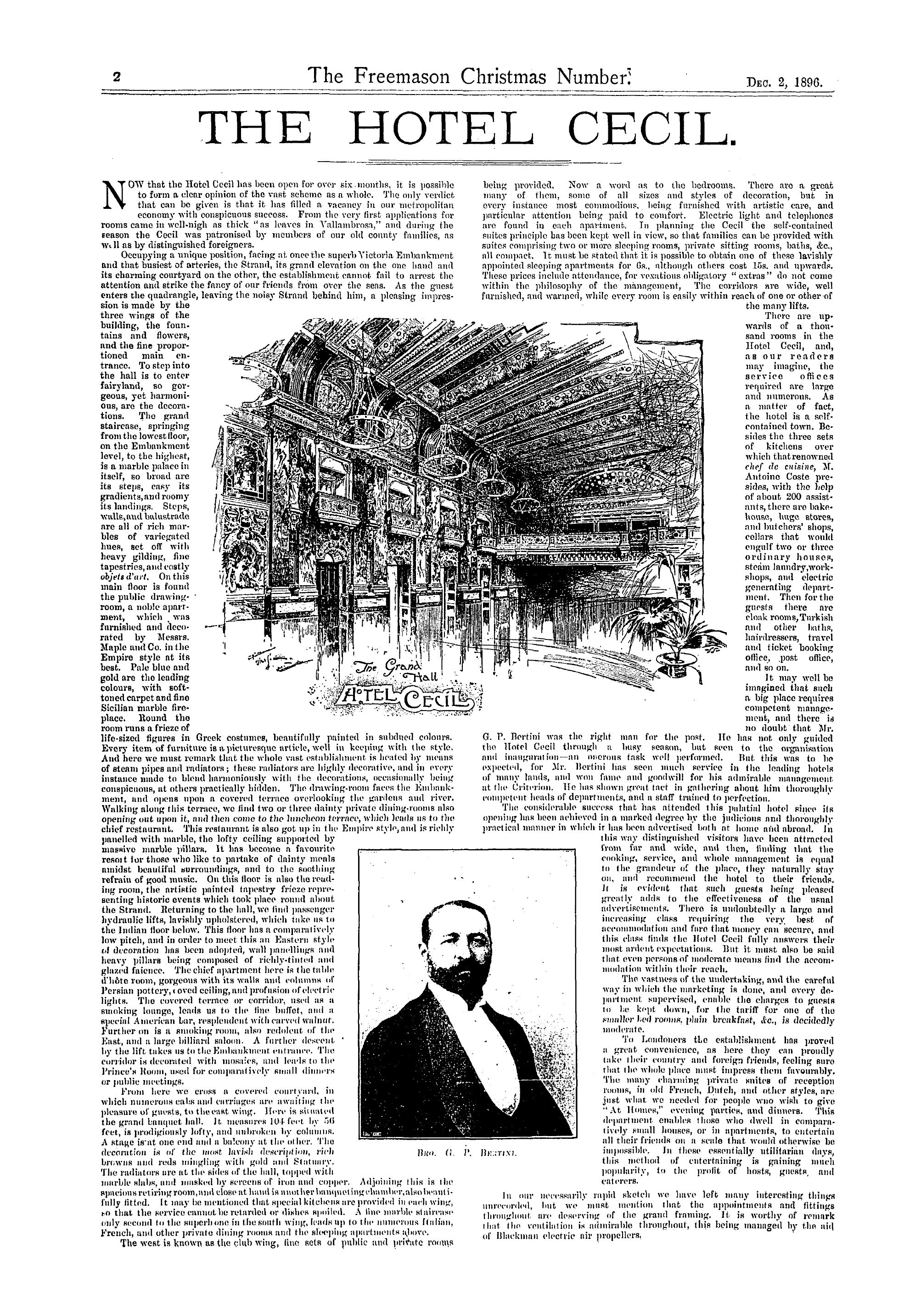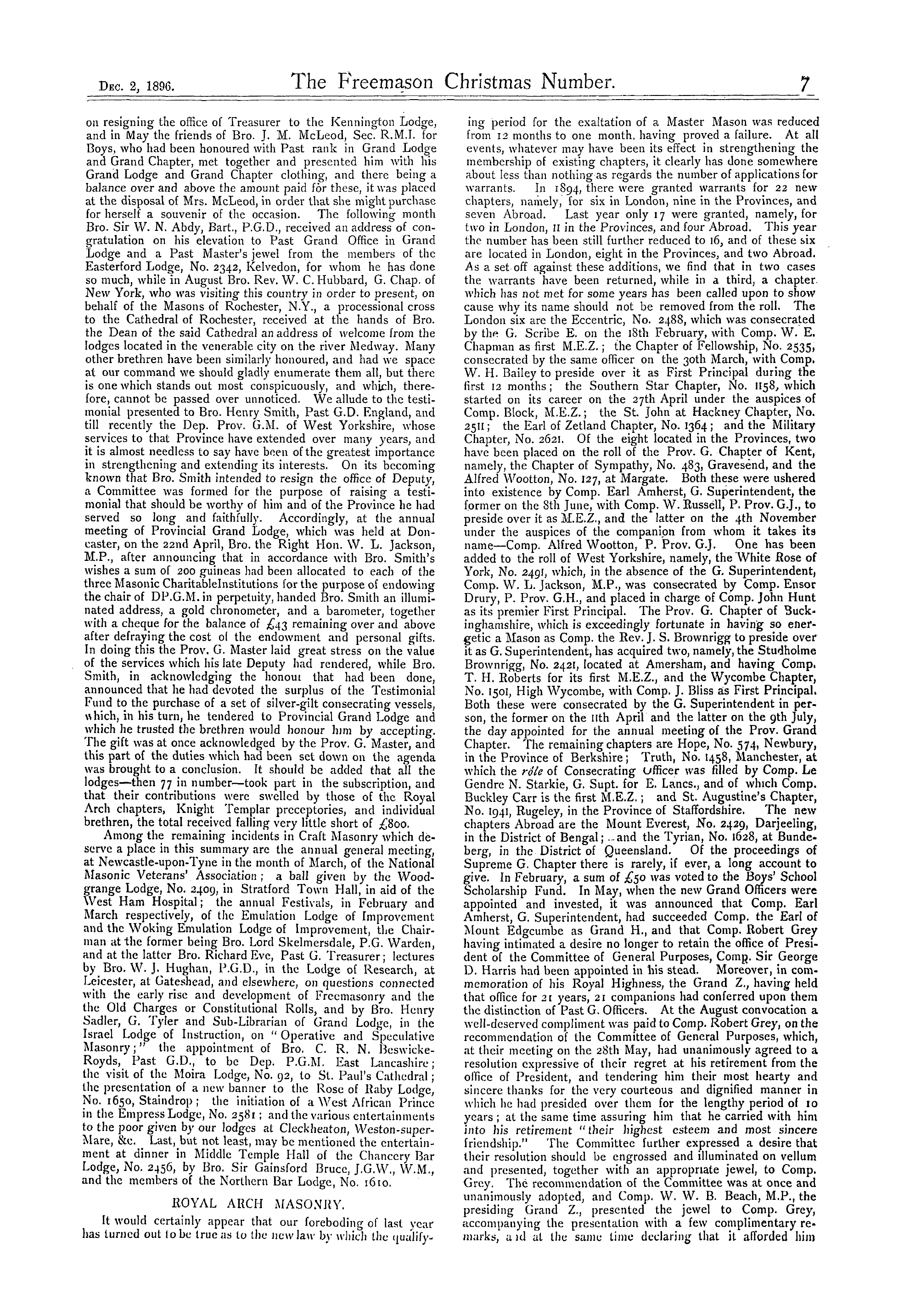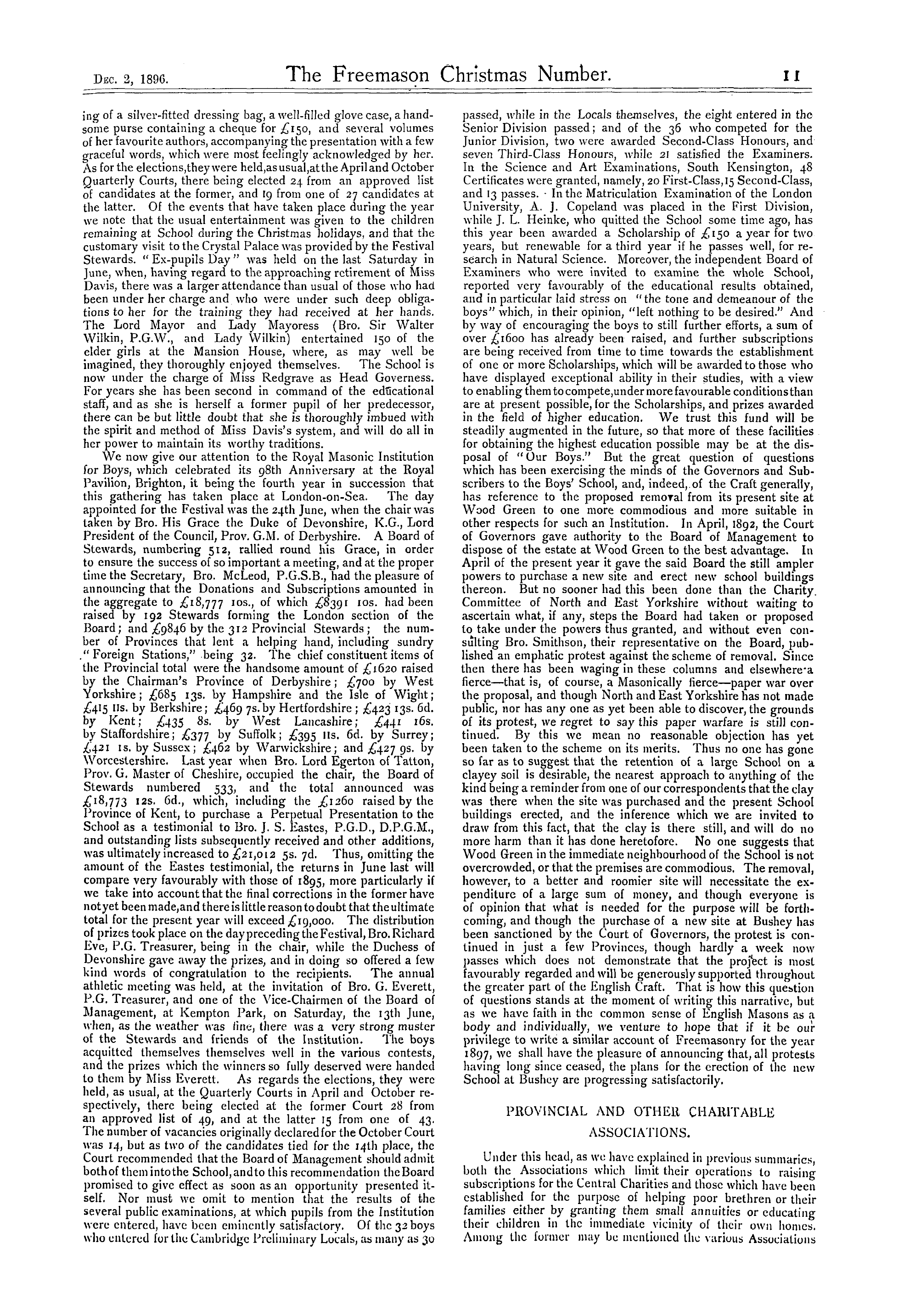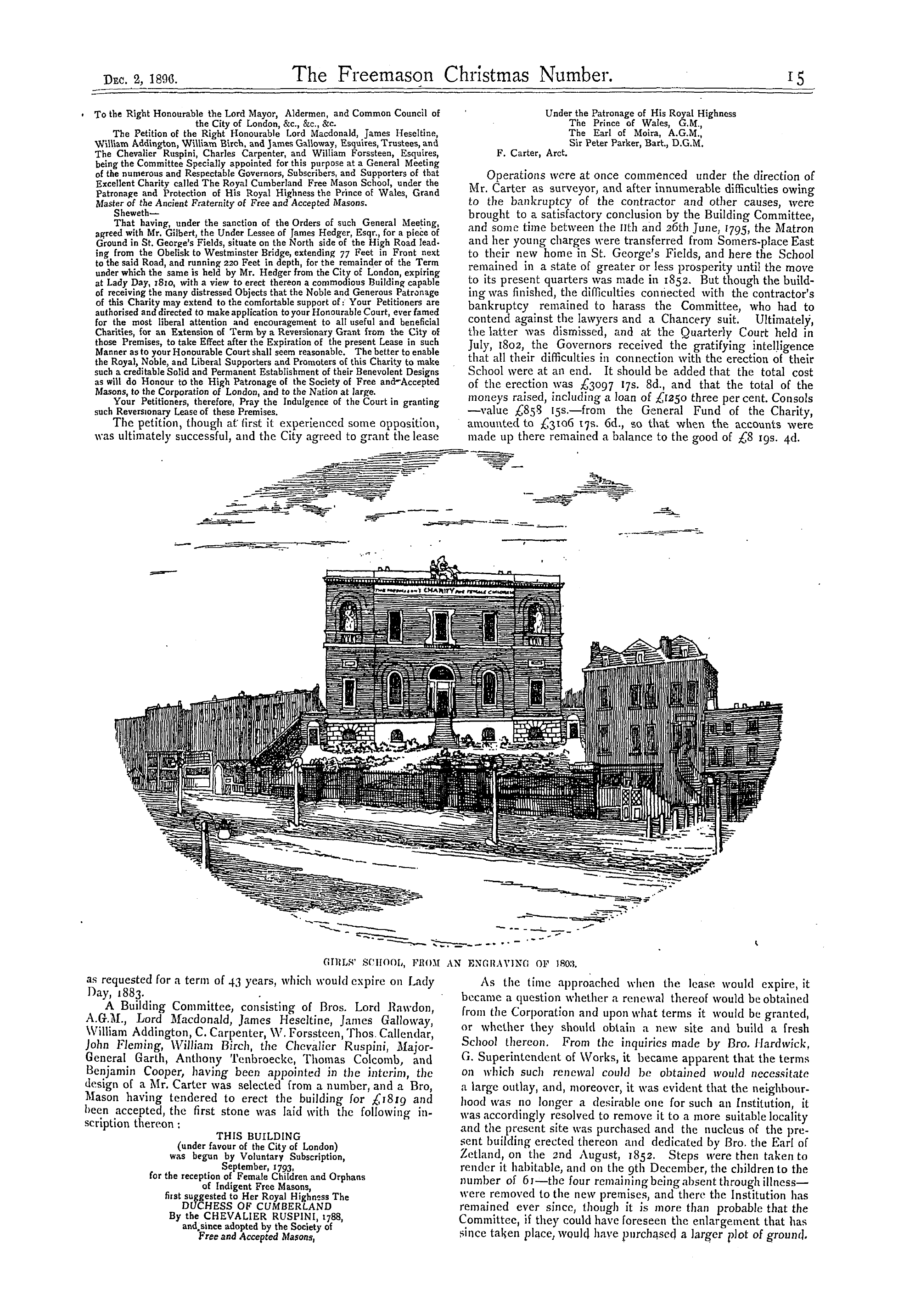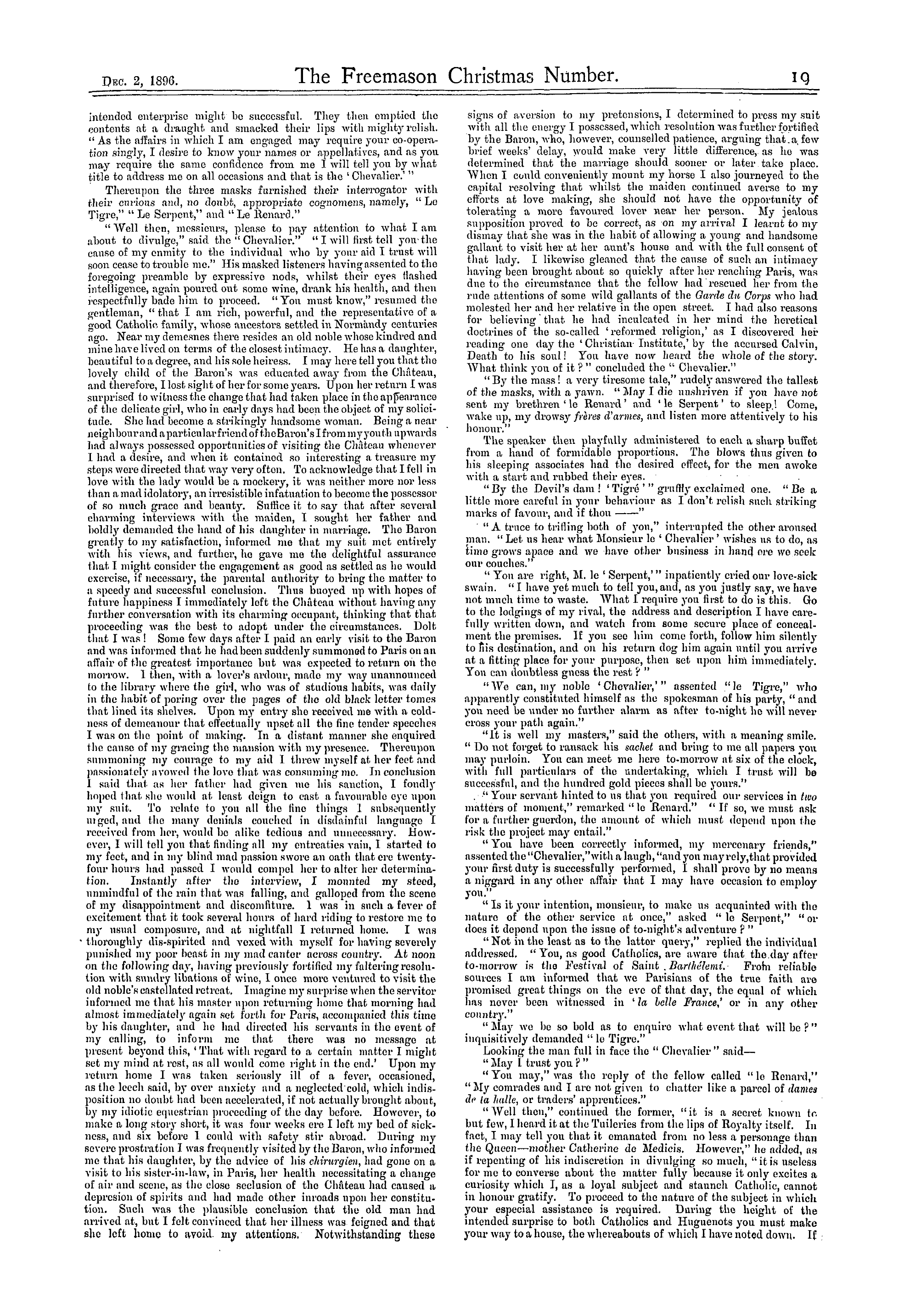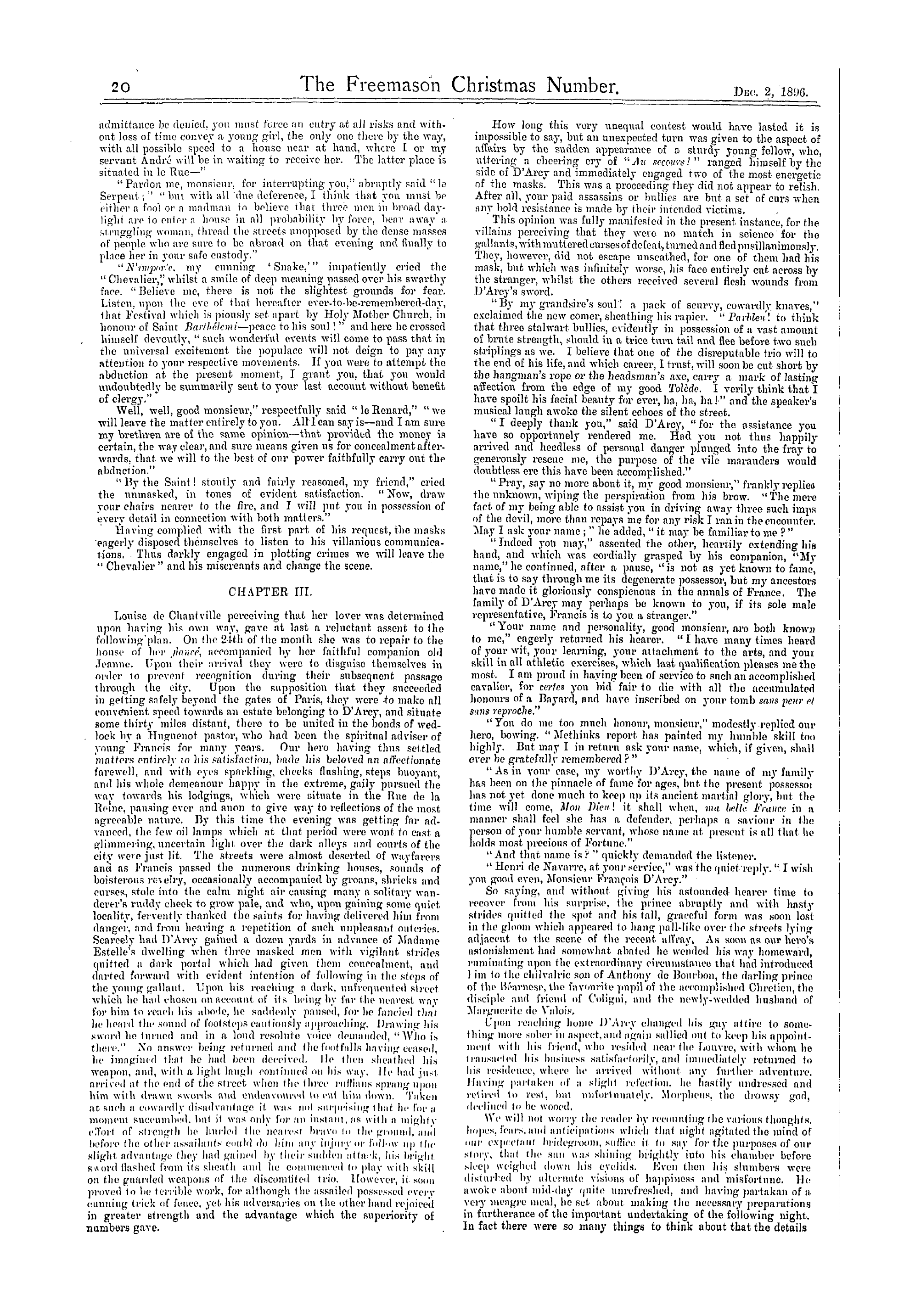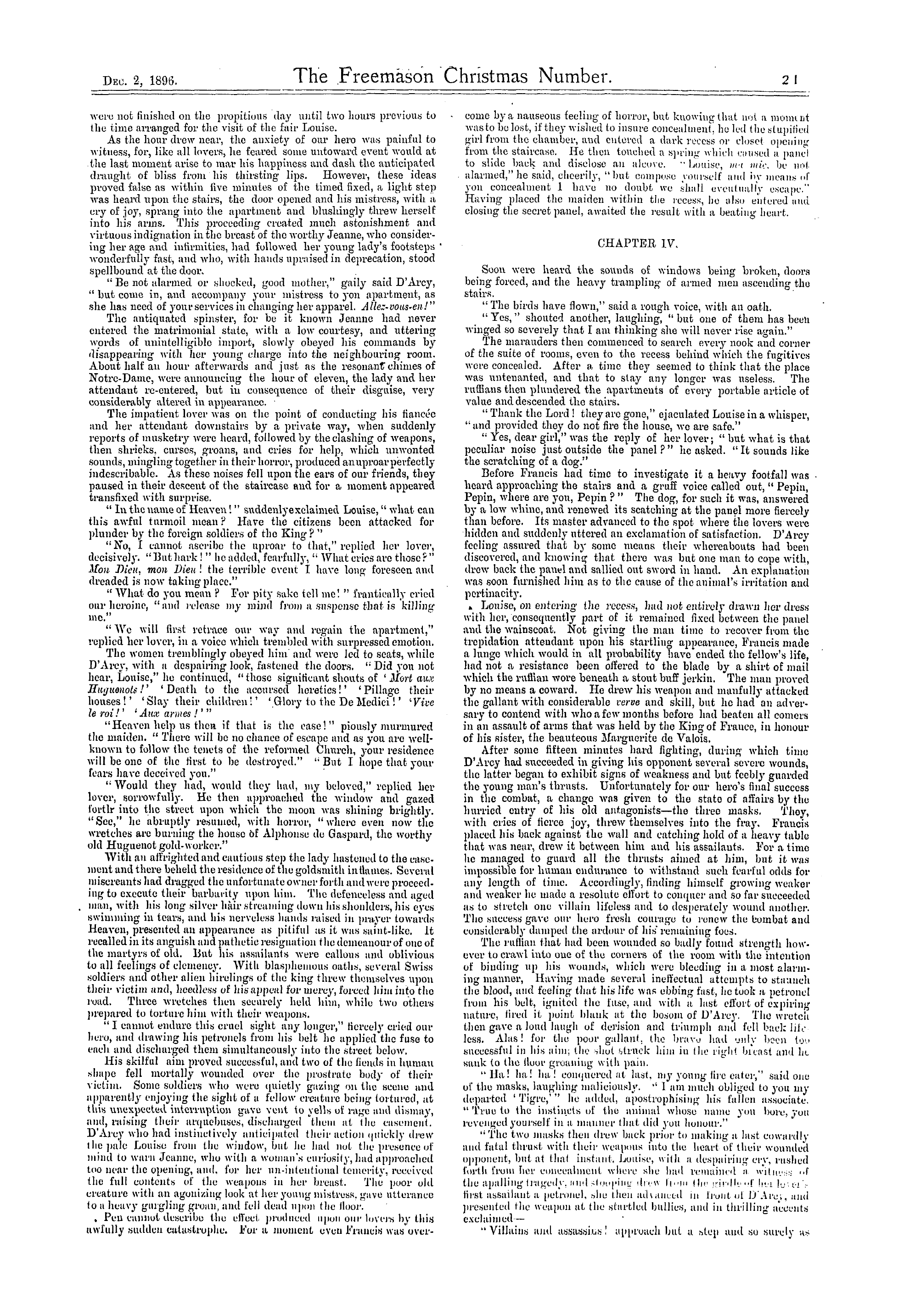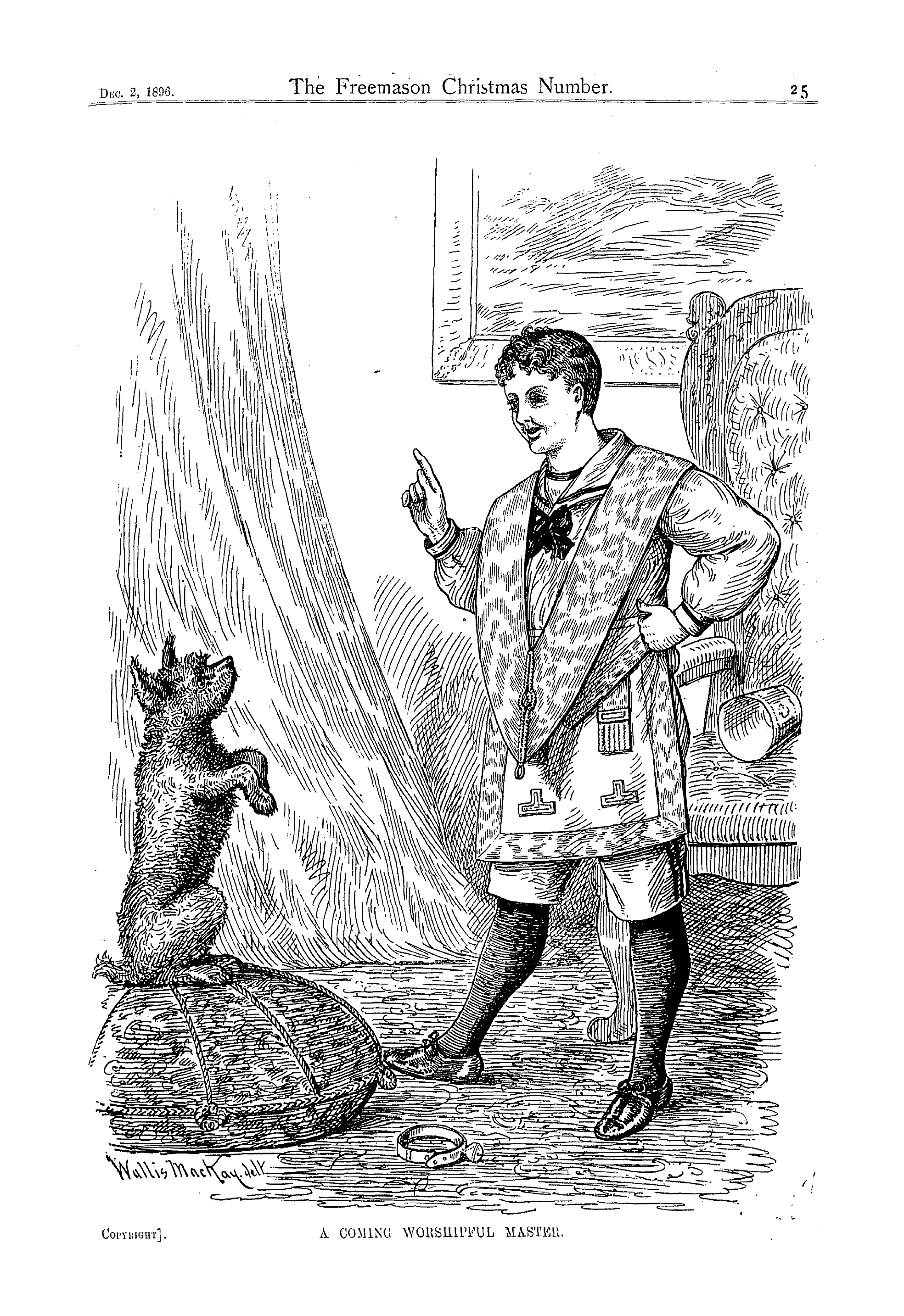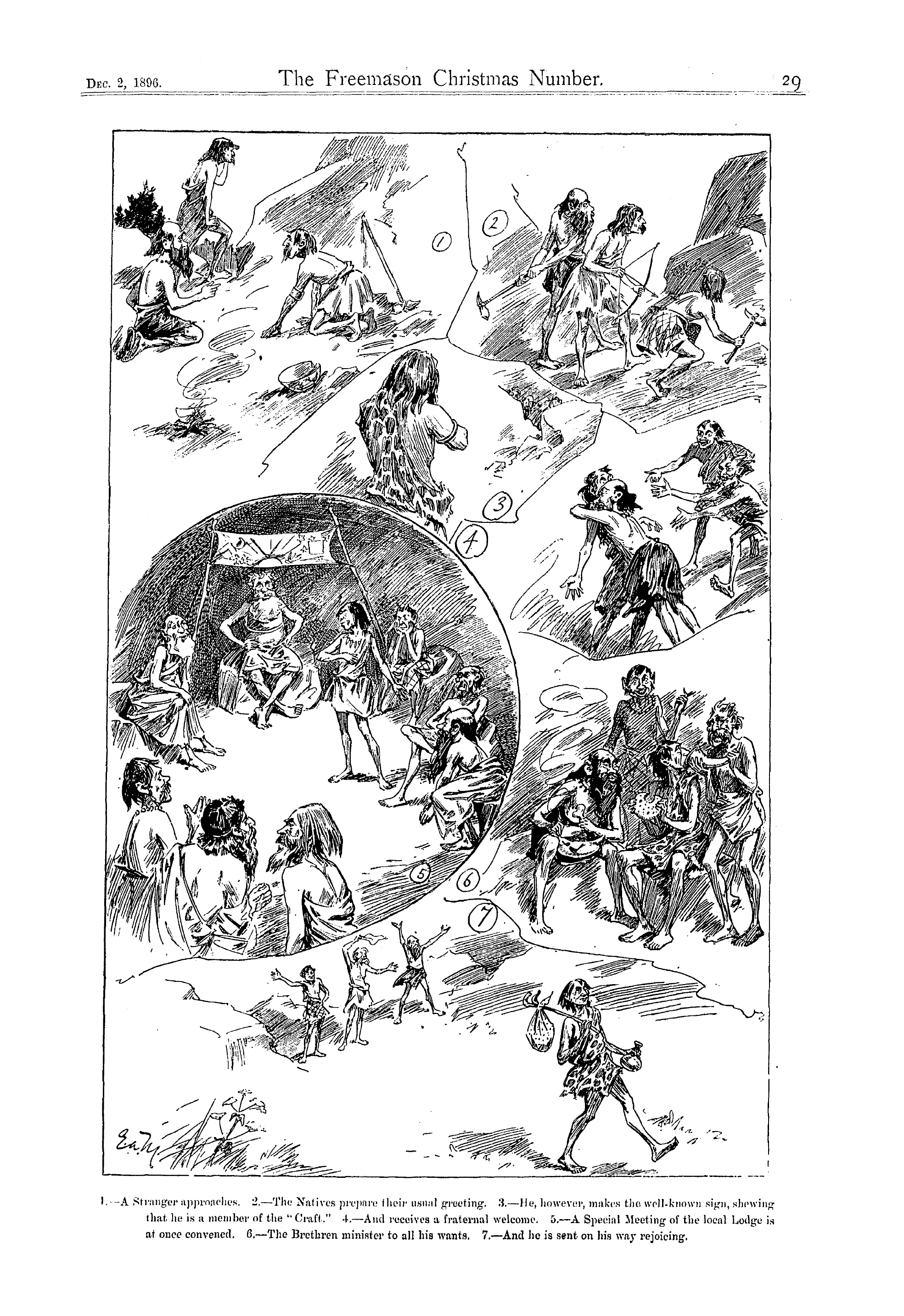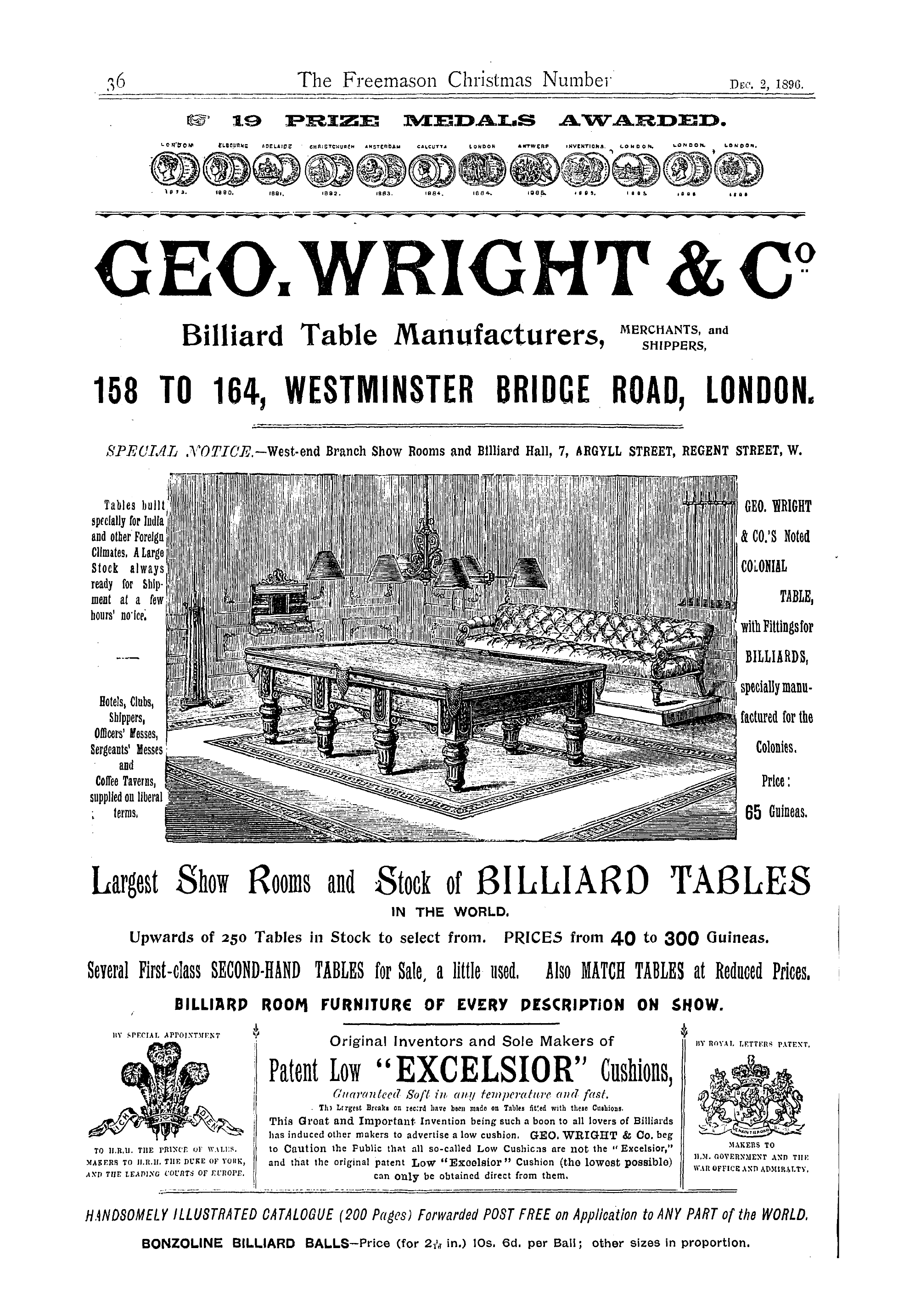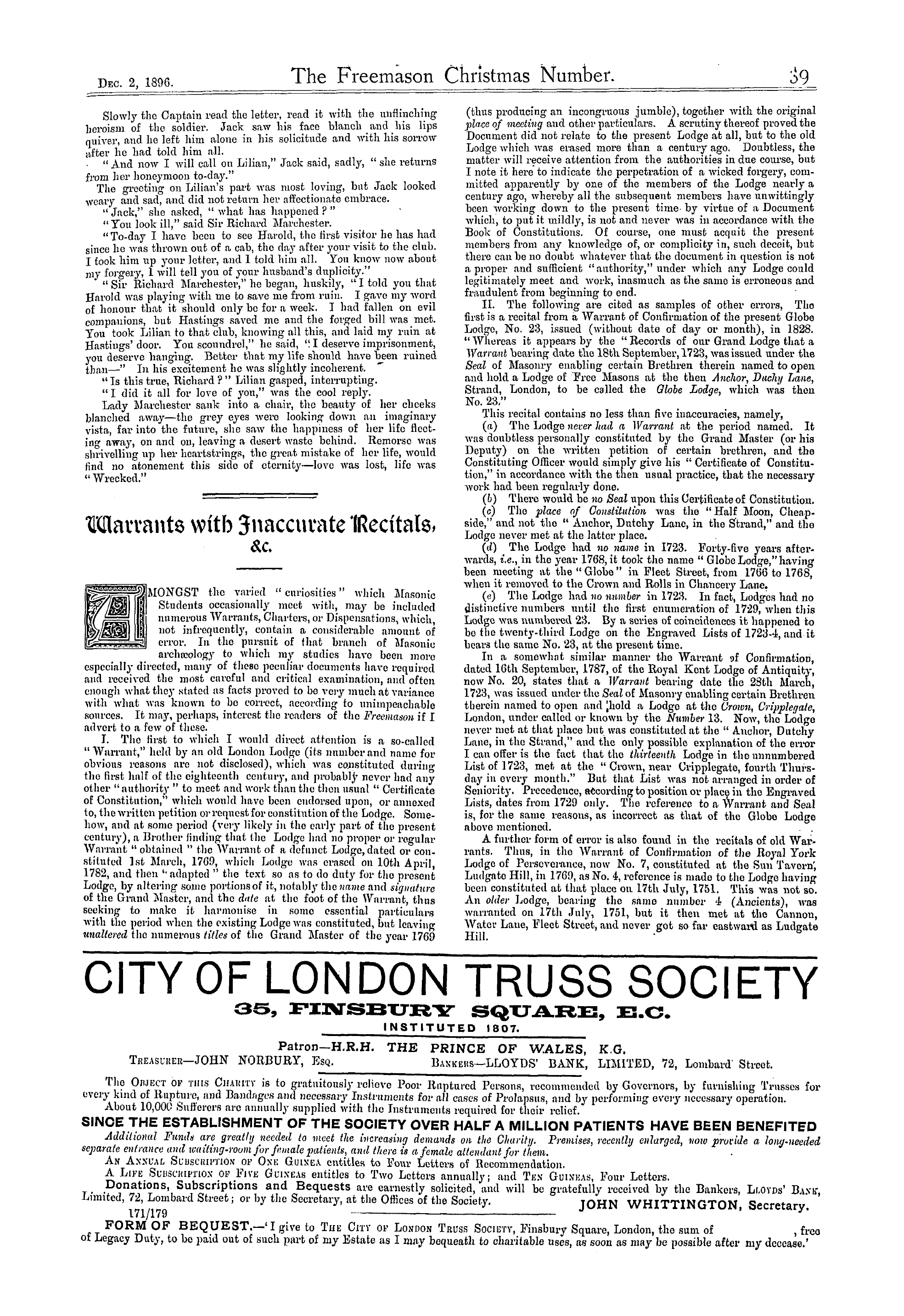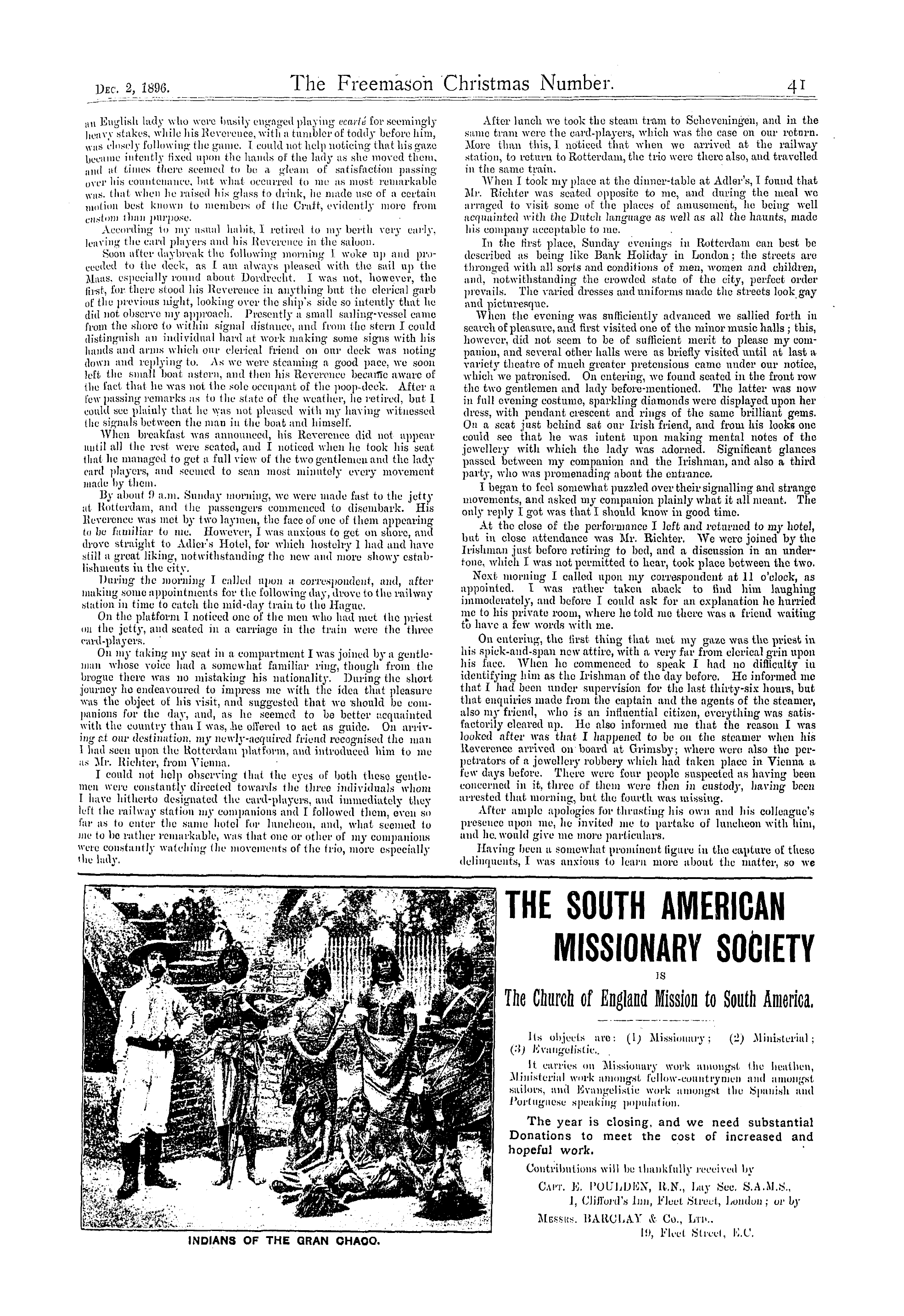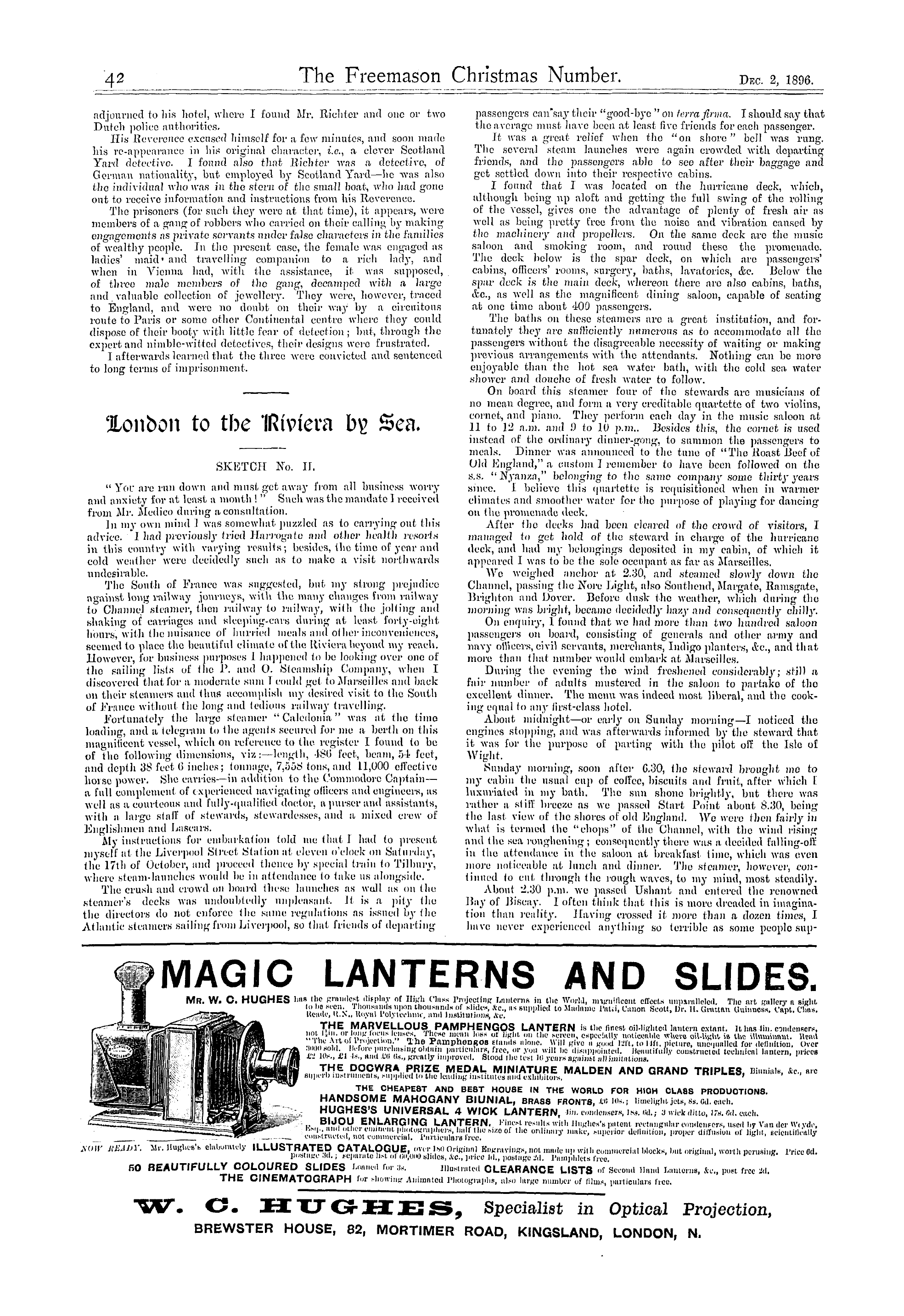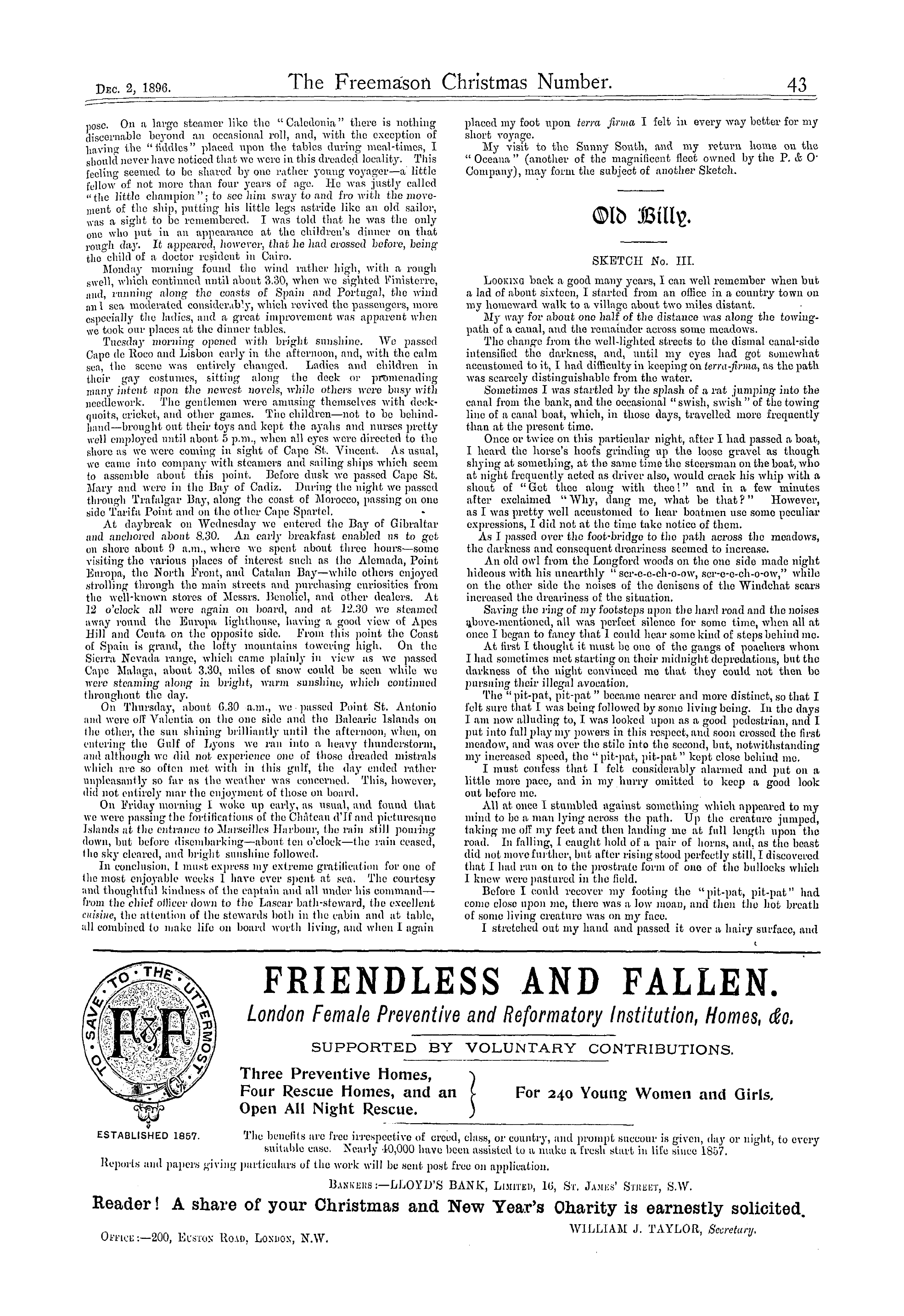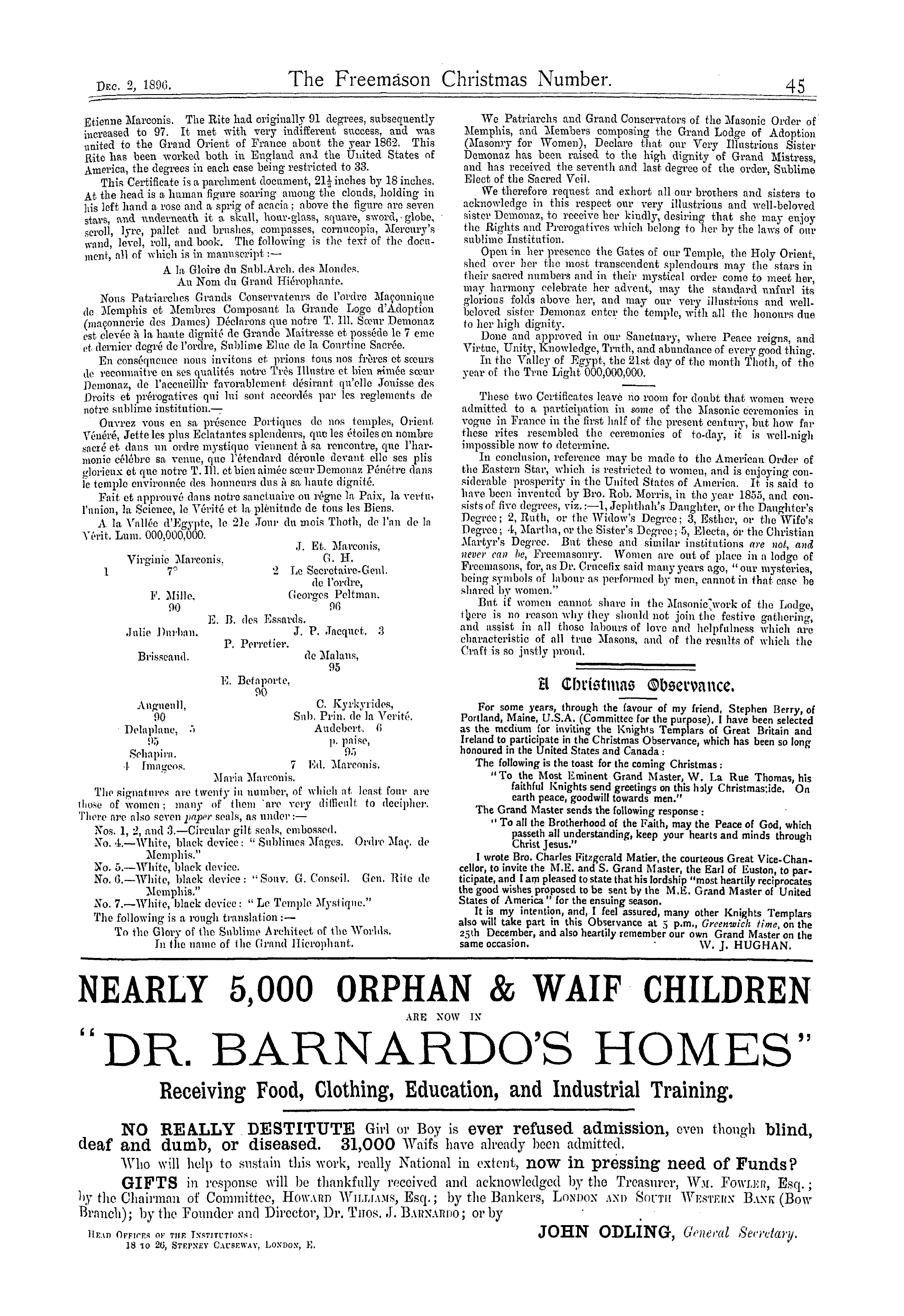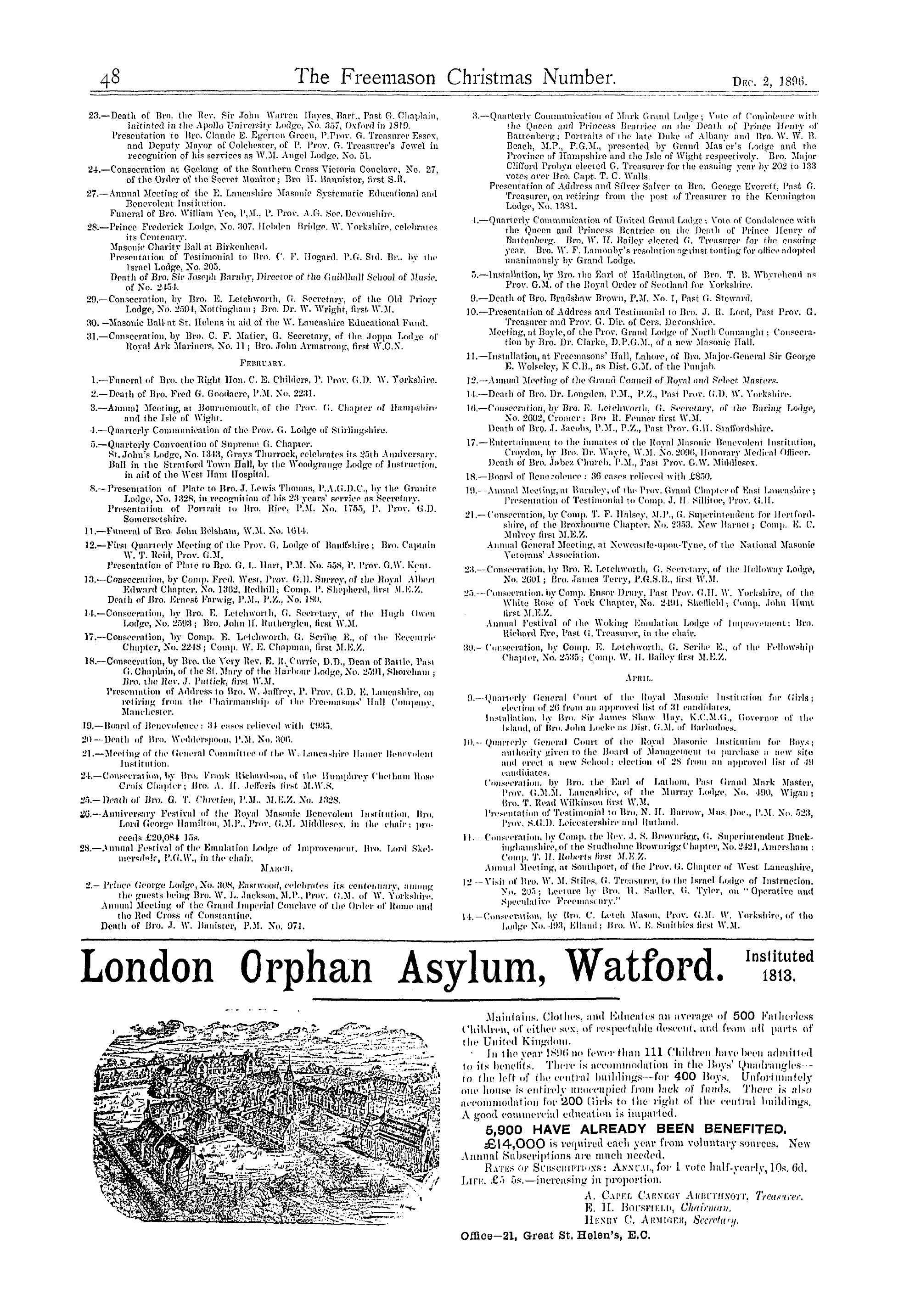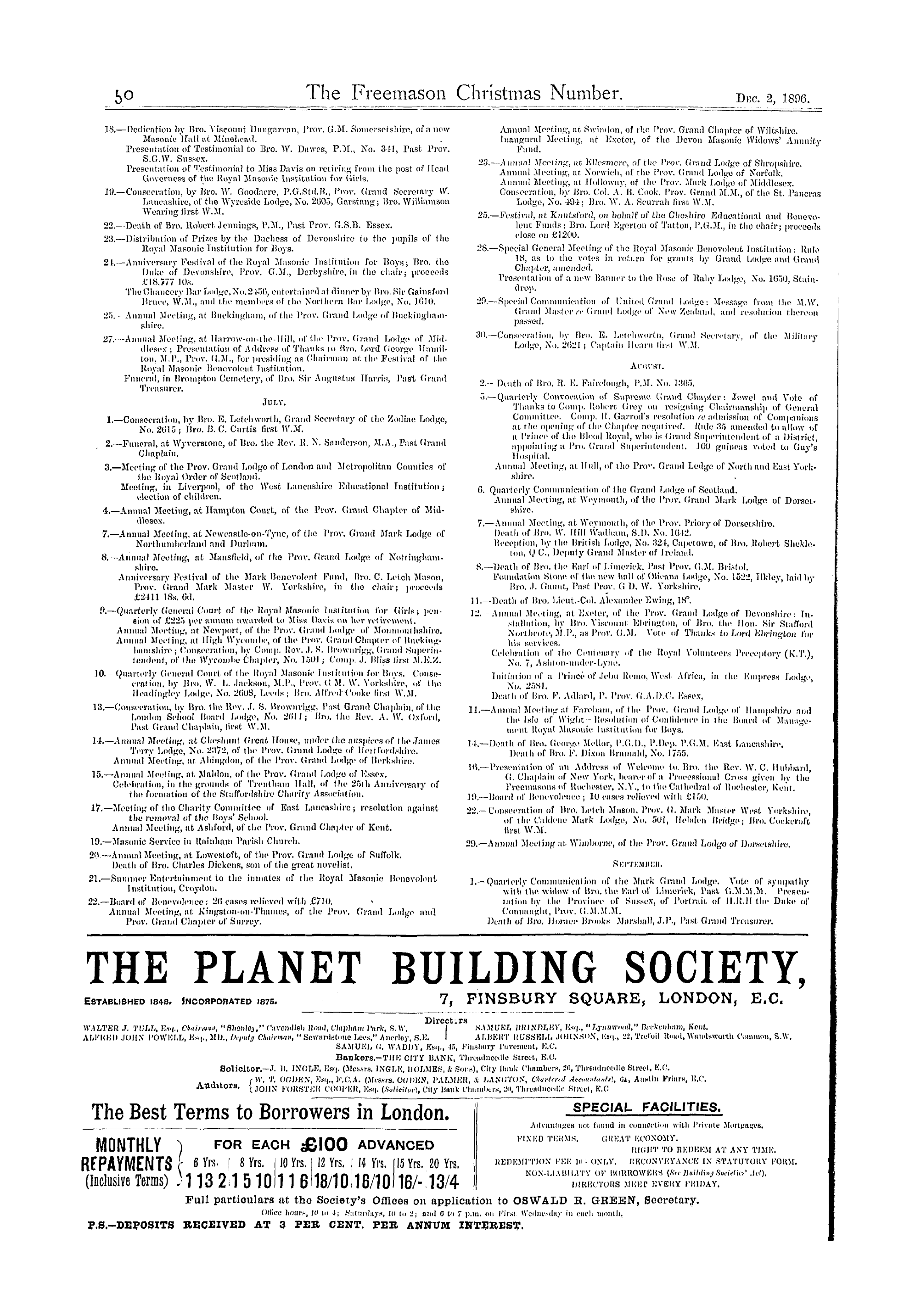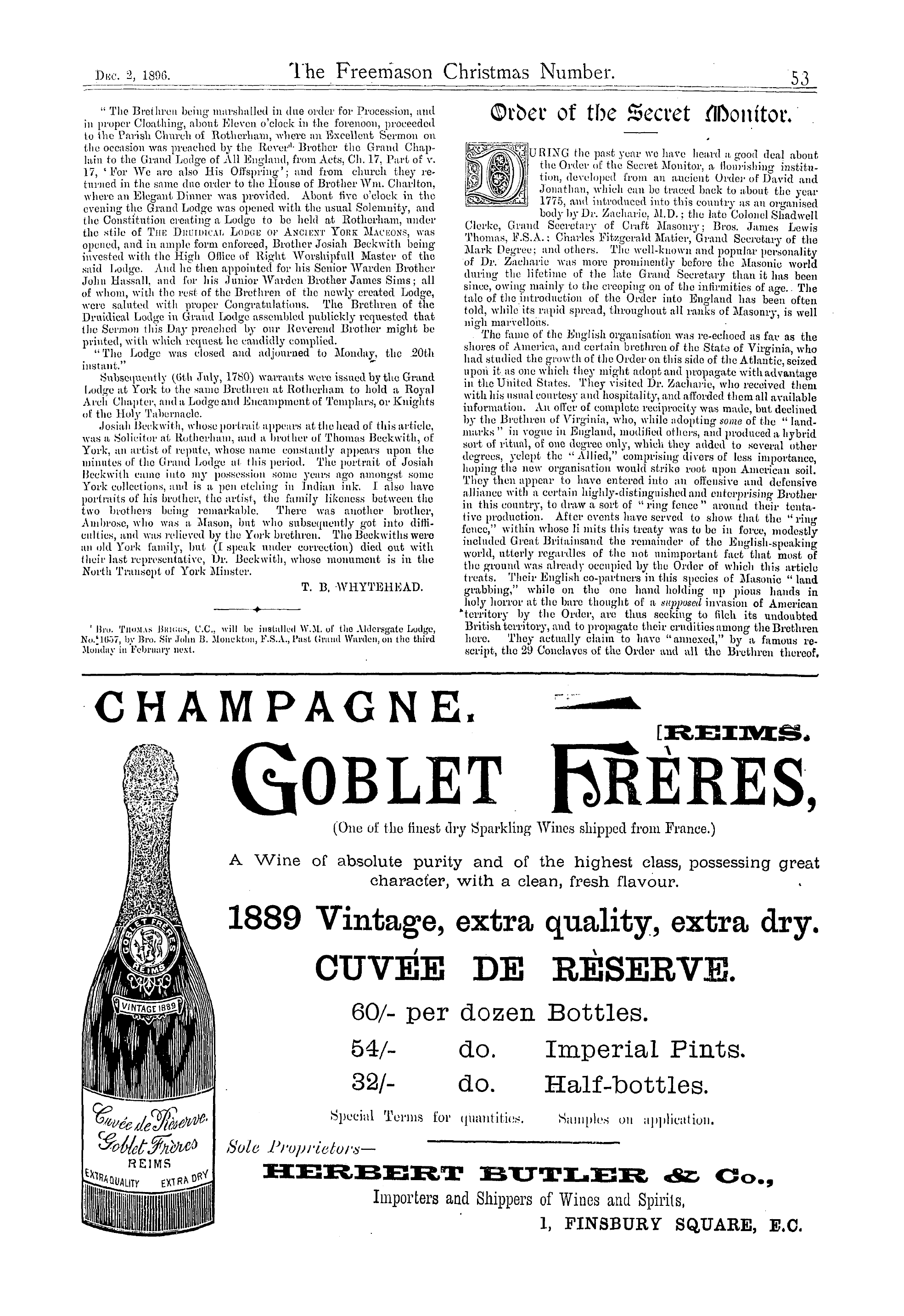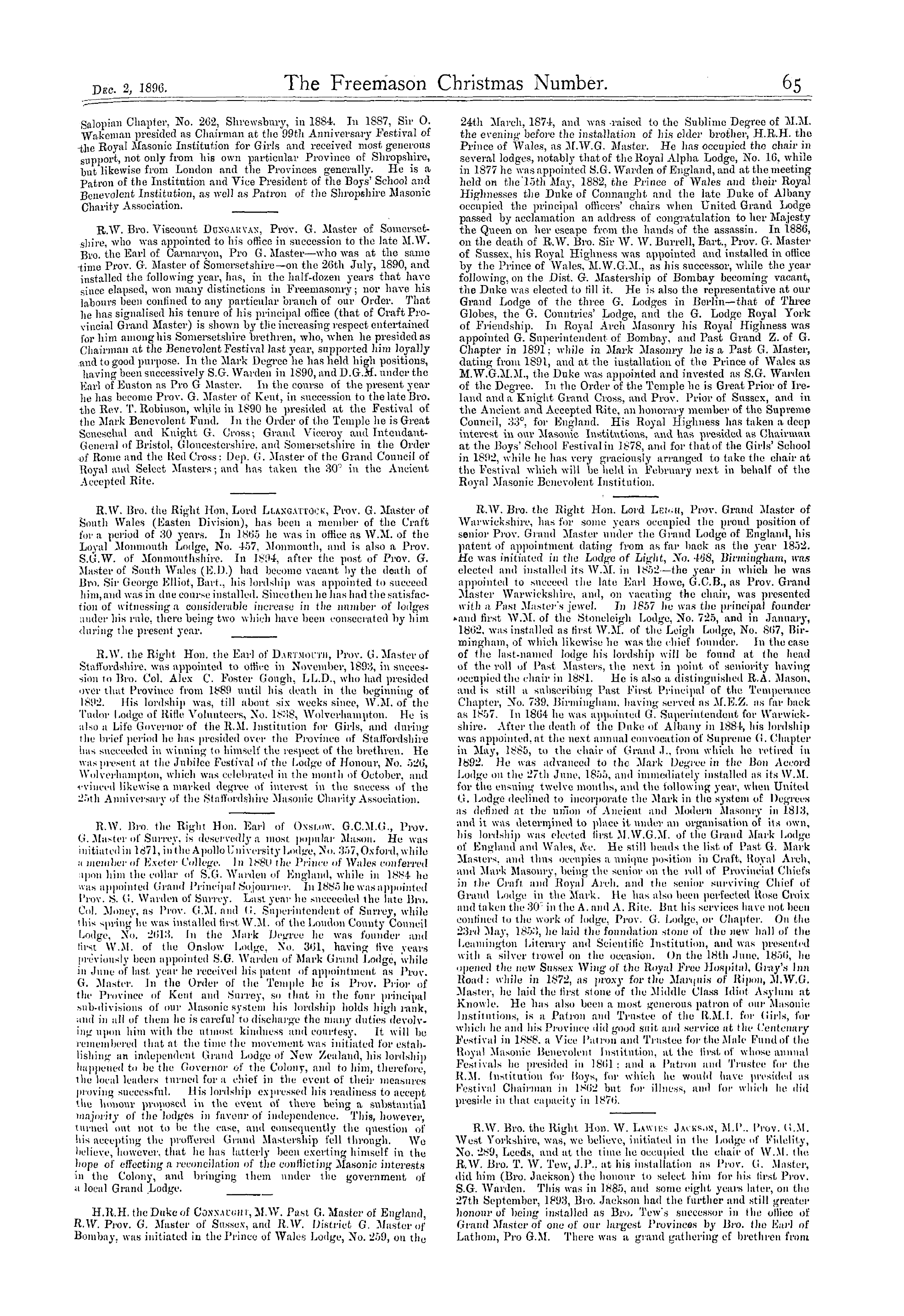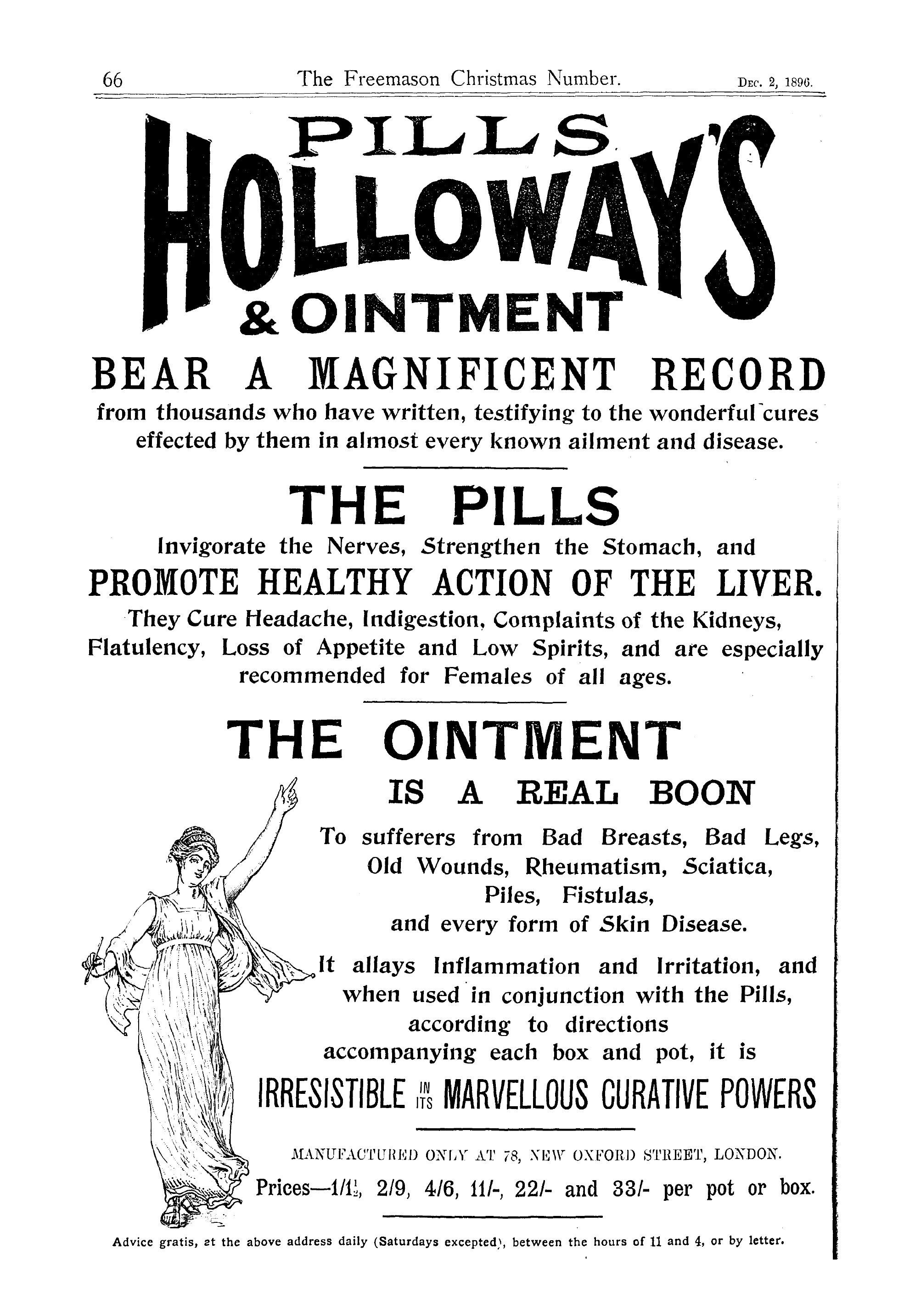-
Articles/Ads
Article Bro. George S. Graham. ← Page 2 of 2 Article Masons' Marks on the Stones of Stretford Aqueduct. Page 1 of 1 Article Masons' Marks on the Stones of Stretford Aqueduct. Page 1 of 1
Note: This text has been automatically extracted via Optical Character Recognition (OCR) software.
Bro. George S. Graham.
distinguished him as a fitting and dignified ruler , and greatly strengthened the brethren in their allegiance and their adherence to their sacred obligations as Masons . Notwithstanding that in many cases he was compelled to adjudicate with firmness , he still retained the respect and esteem of those opposed to him . No one
could feel more keenl y the great responsibilites that devolved upon him under such extremely trying circumstances . At any rate , his generous nature always dictated a kindly sympathy , for in him the tie of friendship is very strong and not easil y severed , but honour and duty claimed his highest considerations , and he acted accordingl y-
It is to be hoped he may be spared for many years to enjoy the dignity of past rank in the evening of his well-spent life , and that his future Masonic career may still prove of service to the devoted brethren of his District .
JOHN BEVAN , Dist . G . M . Wcstland , N . Z .
Masons' Marks On The Stones Of Stretford Aqueduct.
Masons' Marks on the Stones of Stretford Aqueduct .
BY NATHAN HEYWOOD .
pS ^^^ I ^ O understand the signification of the marks on the faces S ^ BBK SJ I ° f the principal stones—of which there arc not less i ( (( Pi ^)) I 'ban sixty specimens ( sec plate)—forming the threc-: jSOi !§| z / I span bridge across Hawthorn Road , Stretford ( erected Ti ^ Tr ^ f ^ l' in 1812 ) , it is essentially necessary to trace their alliance with the history of the defunct guild of
operative r reemasons . Tradition informs us that the first assembly iu Britain of freemen of the guild of operative Masons was held in 287 A . D ., under a charter granted by the Emperor Carausius , of which Albanus ( St . Alban )
was the president , but what became of the guild or the freemen of it for several centuries remains a mystery , An event of the guild took p lace in 926 A . i > ., and in that year King Athelstan granted ( he Freemasons a warrant , and the king ' s brother , Prince Edwin , was constituted its President or Grand Master at York .
As St . Alban and Prince Edwin were certainl y not operative Masons , it must follow that honorary members were admitted into the guild at a wry early date The constitutions of the . societywere revised in ( he reign of King Edward III ., in 1358 , but from some unexplained cause the "Masons' Assemblies " were prohibited
Masons' Marks On The Stones Of Stretford Aqueduct.
by Parliament in 1425 . The Masons , however , appear to have assembled , notwithstanding the prohibition , as in 1450 King Henry VI . was initiated . The Grand Lodge or governing body at York terminated in 1599 , and from that date Masonry in Britain appears to have become purely speculative , and as an operative society ceased to exist .
It was the custom when an operative Mason was made a freeman of his guild to choose for his sole use a mark so as to distinguish his work from that of his brother workmen , and when his work was completed he identified it by engraving his mark usuall y on the face of the stone . To those who arc interested in studying the marks of operative Freemasons in England a plenteous field lies open in our
old cathedrals and abbeys , particularly those of Carlisle , * Furness , and Bolton ; but to the more advanced enqnirer who desires a knowledge of foreign marks his attention is directed to the stones forming the passages of the Pyramids , the underground wall of Jerusalem , and in Herculaneum . Pompeii , Rome , Greece , Gcrmania , Hindoostan , Mexico , Peru , Asia Minor , and other places .
Although the Grand Lodge at York had ceased as a governing body , the Masons continued to meet , and honorary or speculative members were received into their ranks in considerable numbers , and amongst many well-known names arc those of Inigo Jones , Elias Ashmole , t Cardinal Wolsey , Thomas Cromwell ( Earl of Essex ) , and Sir Christopher Wren .
The inconvenience of numerous lodges assembling without a governing body soon became manifest , and the first of a series of Grand Lodges was instituted iu 1717 in England , and Scotland and IrelandJ had each a Grand Lodge constituted at a later period . The custom of allowing the speculative Freemason to choose a
mark was not much practised in England , but in Scotland and Ireland it was usual for the candidate to do so , especially if he were a stonemason b y trade . An example of Robert Burn ' s mark will bo . found written in the Bible he presented to the object of his affections , who afterwards became immortalised in the poem entitled " Mary in Heaven . "
[ Thou ling ring slur , with less mug ray , That lov ' st to greet the early morn , Again thou usher'sc in the day My Mary from my soul was torn . 0 Mary . ' dear departed shade ! Where is thy place of blissful rest ' t See ' st thou thy lover lowly laid ?
Hear'st thou the groans that rend his breast ' ' j and I am informed ( upon the authority of my late father ) that the mark of Ivie Mackie . thrice mayor of Manchester , is fo be found on one of the p illars of the General Post Office , St . Martin ' s-lc-Grand , Loudon .
As it is an ascertained fact that ( he aqueduct at Stretford is a comparativel y modern structure , it is onl y reasonable to assume that the marked stones are the handiwork of speculative Masons ( probabl y Scotch ) who were also masons by trade . The stones have been doubtless marked to identify the labour performed by the respective
workmen whose marks appear upon them , and answer all the useful purposes of the freemen of the operative Masonic guilds . It is not an unfrcqucnt occurrence to find the marks of two workmen engraved on the same stone , and several examples arc prominent at Stretford .
Although every member of a Lodge had a mark peculiar to himself , it frequently occurred that members of many Lodges were employed on the common structure , and , therefore , more than one workman might possess the same mark , and to avoid confusion such Masons would for a time assume distinctions or differences by adding an extra stroke to some part of their respective marks .
Certain marks were special iiivoiirites with the cralt , the most frequent of which are the marks known as "the hour-glass , " " the pentagon , " " ( he hexagon , " "the triangle , " "the cross , " '' the trident , " " the alp ha , " and " the square and compasses , " all of which are represented at Stretford .
Inasmuch as the engraved mark ' s are usuall y from seven to nine inches in height , if is curious that so many antiquaries of note have walked beneath this bridge without observing the marks so prominently engraved on the faces of the stones , but scarcel y so
remarkable as the record of an old French priest , the walls of whose church at Poitiers were literally covered with marks , said : " I have walked through this church four times a day , twenty-eight times a week for nearl y forty years , and never noticed one of them ; and now I cannot look anvwlierc , but they flit into my eyes . "
t Klius Aslnmilc wns initiated al Warrington in lltl-li iritli Culmiel llv . Miiinwaring ; Kiehard I ' cukei . Juincs Collier , ltieluu-d Satilcoy , and utliers we ' re members of ihe lodge ill tlnil time .
X . Scotland , 17 ' . W . Miiii « ieriihoiii 17-0 ; J . cinsicr alioul 17- ! l-: i ( l , and i-cor-inu ' seil : ird January , 17111 .
Note: This text has been automatically extracted via Optical Character Recognition (OCR) software.
Bro. George S. Graham.
distinguished him as a fitting and dignified ruler , and greatly strengthened the brethren in their allegiance and their adherence to their sacred obligations as Masons . Notwithstanding that in many cases he was compelled to adjudicate with firmness , he still retained the respect and esteem of those opposed to him . No one
could feel more keenl y the great responsibilites that devolved upon him under such extremely trying circumstances . At any rate , his generous nature always dictated a kindly sympathy , for in him the tie of friendship is very strong and not easil y severed , but honour and duty claimed his highest considerations , and he acted accordingl y-
It is to be hoped he may be spared for many years to enjoy the dignity of past rank in the evening of his well-spent life , and that his future Masonic career may still prove of service to the devoted brethren of his District .
JOHN BEVAN , Dist . G . M . Wcstland , N . Z .
Masons' Marks On The Stones Of Stretford Aqueduct.
Masons' Marks on the Stones of Stretford Aqueduct .
BY NATHAN HEYWOOD .
pS ^^^ I ^ O understand the signification of the marks on the faces S ^ BBK SJ I ° f the principal stones—of which there arc not less i ( (( Pi ^)) I 'ban sixty specimens ( sec plate)—forming the threc-: jSOi !§| z / I span bridge across Hawthorn Road , Stretford ( erected Ti ^ Tr ^ f ^ l' in 1812 ) , it is essentially necessary to trace their alliance with the history of the defunct guild of
operative r reemasons . Tradition informs us that the first assembly iu Britain of freemen of the guild of operative Masons was held in 287 A . D ., under a charter granted by the Emperor Carausius , of which Albanus ( St . Alban )
was the president , but what became of the guild or the freemen of it for several centuries remains a mystery , An event of the guild took p lace in 926 A . i > ., and in that year King Athelstan granted ( he Freemasons a warrant , and the king ' s brother , Prince Edwin , was constituted its President or Grand Master at York .
As St . Alban and Prince Edwin were certainl y not operative Masons , it must follow that honorary members were admitted into the guild at a wry early date The constitutions of the . societywere revised in ( he reign of King Edward III ., in 1358 , but from some unexplained cause the "Masons' Assemblies " were prohibited
Masons' Marks On The Stones Of Stretford Aqueduct.
by Parliament in 1425 . The Masons , however , appear to have assembled , notwithstanding the prohibition , as in 1450 King Henry VI . was initiated . The Grand Lodge or governing body at York terminated in 1599 , and from that date Masonry in Britain appears to have become purely speculative , and as an operative society ceased to exist .
It was the custom when an operative Mason was made a freeman of his guild to choose for his sole use a mark so as to distinguish his work from that of his brother workmen , and when his work was completed he identified it by engraving his mark usuall y on the face of the stone . To those who arc interested in studying the marks of operative Freemasons in England a plenteous field lies open in our
old cathedrals and abbeys , particularly those of Carlisle , * Furness , and Bolton ; but to the more advanced enqnirer who desires a knowledge of foreign marks his attention is directed to the stones forming the passages of the Pyramids , the underground wall of Jerusalem , and in Herculaneum . Pompeii , Rome , Greece , Gcrmania , Hindoostan , Mexico , Peru , Asia Minor , and other places .
Although the Grand Lodge at York had ceased as a governing body , the Masons continued to meet , and honorary or speculative members were received into their ranks in considerable numbers , and amongst many well-known names arc those of Inigo Jones , Elias Ashmole , t Cardinal Wolsey , Thomas Cromwell ( Earl of Essex ) , and Sir Christopher Wren .
The inconvenience of numerous lodges assembling without a governing body soon became manifest , and the first of a series of Grand Lodges was instituted iu 1717 in England , and Scotland and IrelandJ had each a Grand Lodge constituted at a later period . The custom of allowing the speculative Freemason to choose a
mark was not much practised in England , but in Scotland and Ireland it was usual for the candidate to do so , especially if he were a stonemason b y trade . An example of Robert Burn ' s mark will bo . found written in the Bible he presented to the object of his affections , who afterwards became immortalised in the poem entitled " Mary in Heaven . "
[ Thou ling ring slur , with less mug ray , That lov ' st to greet the early morn , Again thou usher'sc in the day My Mary from my soul was torn . 0 Mary . ' dear departed shade ! Where is thy place of blissful rest ' t See ' st thou thy lover lowly laid ?
Hear'st thou the groans that rend his breast ' ' j and I am informed ( upon the authority of my late father ) that the mark of Ivie Mackie . thrice mayor of Manchester , is fo be found on one of the p illars of the General Post Office , St . Martin ' s-lc-Grand , Loudon .
As it is an ascertained fact that ( he aqueduct at Stretford is a comparativel y modern structure , it is onl y reasonable to assume that the marked stones are the handiwork of speculative Masons ( probabl y Scotch ) who were also masons by trade . The stones have been doubtless marked to identify the labour performed by the respective
workmen whose marks appear upon them , and answer all the useful purposes of the freemen of the operative Masonic guilds . It is not an unfrcqucnt occurrence to find the marks of two workmen engraved on the same stone , and several examples arc prominent at Stretford .
Although every member of a Lodge had a mark peculiar to himself , it frequently occurred that members of many Lodges were employed on the common structure , and , therefore , more than one workman might possess the same mark , and to avoid confusion such Masons would for a time assume distinctions or differences by adding an extra stroke to some part of their respective marks .
Certain marks were special iiivoiirites with the cralt , the most frequent of which are the marks known as "the hour-glass , " " the pentagon , " " ( he hexagon , " "the triangle , " "the cross , " '' the trident , " " the alp ha , " and " the square and compasses , " all of which are represented at Stretford .
Inasmuch as the engraved mark ' s are usuall y from seven to nine inches in height , if is curious that so many antiquaries of note have walked beneath this bridge without observing the marks so prominently engraved on the faces of the stones , but scarcel y so
remarkable as the record of an old French priest , the walls of whose church at Poitiers were literally covered with marks , said : " I have walked through this church four times a day , twenty-eight times a week for nearl y forty years , and never noticed one of them ; and now I cannot look anvwlierc , but they flit into my eyes . "
t Klius Aslnmilc wns initiated al Warrington in lltl-li iritli Culmiel llv . Miiinwaring ; Kiehard I ' cukei . Juincs Collier , ltieluu-d Satilcoy , and utliers we ' re members of ihe lodge ill tlnil time .
X . Scotland , 17 ' . W . Miiii « ieriihoiii 17-0 ; J . cinsicr alioul 17- ! l-: i ( l , and i-cor-inu ' seil : ird January , 17111 .

